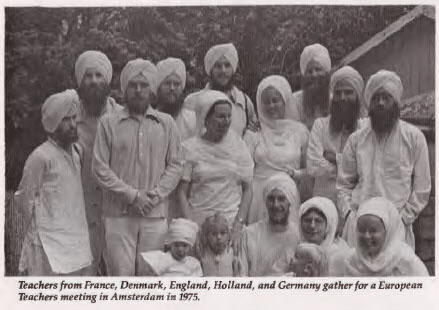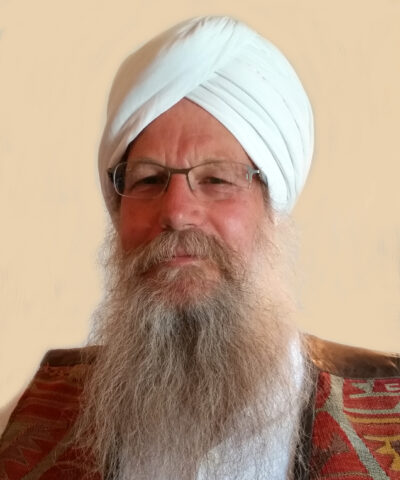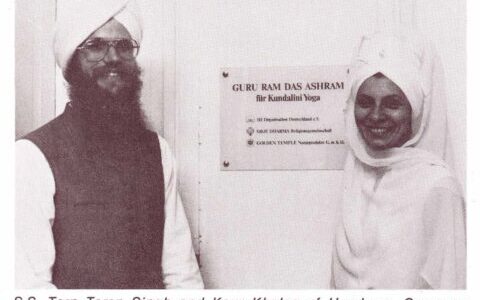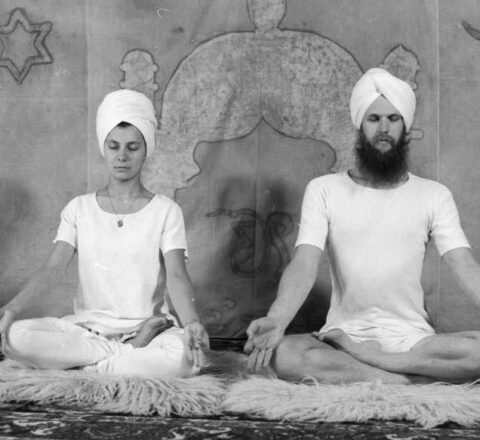by SS Tarn Taran Singh Khalsa, Espanola NM (as told to/edited by SS Dr. Shanti Shanti Kaur Khalsa)
Spring (Second Quarter)
Shanti Shanti Kaur: In this issue of the Sikh Dharma Ministry newsletter, we’re reflecting on the evolution of our community over the past 50 years. Within our organization—during the 1980s and ‘90s—the regional director system became less relevant. Sangat community councils and businesses became more prevalent. Also, we became a more global sangat.
During this time, Tarn Taran Singh, you were the Regional Director for Europe and Africa. You served as an ashram head, and you were running the earliest 3HO/Sikh Dharma businesses in Europe: the Golden Temple Restaurant and the Yogi Tea Company. Your service was vital to this evolutionary time period. Would you reflect on what life was like for you and the European sangat during these two pivotal decades?
Tarn Taran Singh: First, I think it’s very interesting to have this opportunity to reflect on being a Sikh Dharma Minister. My father was a Minister. My grandfather was a Minister. I learned from them that ministering includes bringing people together and working mutually so everyone has a voice. To me, the role of a minister makes complete sense.
For me, dharma is the underlying principle that holds everything together. What we call “dharma” is a pathway for coming into harmony and connection. Dharma is not a religion. It’s a pathway.
Tarn Taran Kaur and I started out in 1972 as hippies on the road. We stopped in Tucson, Arizona, where we attended a full moon feast at the ashram there. We started to do yoga with a group of young people. They were seekers like ourselves who had found a framework in which to live together to become more aware of ourselves on a spiritual level and serve a broader community.
And that’s when we met Yogi Bhajan. At one point, I asked him about starting an ashram in Indiana. Yogiji said, “Why don’t you go to Amsterdam?” We said, “Okay.” The first 3HO ashram in Europe was in London, so we started by visiting there. When we were in the Southhall area of London we learned from the Punjabi Sikhs how to conduct a Gurdwara.
Then we moved on to Amsterdam to join the couple who had started the ashram there. For young people from all over the world, Amsterdam was the alternative cultural center on the European continent. So people from all over Europe and around the globe showed up at our ashram.
The first thing we experienced in Europe was culture shock. Housing is on a much smaller scale than in the US. We had a very little apartment in a certain part of Amsterdam. Downstairs they had started a restaurant. Yogiji’s sister lived in London and he had arranged for her to come over and teach Indian cooking
After two years in Amsterdam, Tarn Taran Kaur and I moved to Germany. In Hamburg, a group of young people was trying to turn an old factory into a spiritual center. They ran a vegetarian restaurant and they were trying to teach yoga classes. They invited us to come because they thought having an ashram in the building would help to solidify their vision. So we came. We were struggling with how to earn money and that’s how we created the Yogi Tea business.
We discovered that in Europe there was a deep sense of cultural identity. People weren’t necessarily looking for another family or searching for a deeper meaning. They already had that. Also, initially, there was no Sikh Dharma. That slowly started to seep in over time.
Shanti Shanti Kaur: That was part of the evolution of those decades.
Tarn Taran Singh: Absolutely. At our 3HO Summer Solstice in New Mexico in the 1980s, you would find 95% Sikhs and a few yoga students. At the European Yoga Festival, we had 90% yoga students and 10% Sikhs. Some of the students in Europe became Sikhs. But for the most part, the European community base is our yogis.
After we had served to establish 3HO and the businesses in Hamburg over many years, Yogiji sent me back to the United States. That’s when I felt that everything was ripped out from under me. We had to sell the restaurant in Hamburg and then he sent me to Eugene, Oregon.
I questioned, “Why did he do this?” Partly, I know I was burnt out and needed a change. He took away all of my titles, including my Minister title. So it was the worst time, but also the best. I felt useless and worthless. I thought, “I haven’t done anything.” That’s when I started to teach yoga because in Eugene they needed someone to teach a Saturday yoga class. And that’s what saved me. I got a positive response. That was when I realized that I was starting to move from the “doing” phase to the “being” part of my life.
Shanti Shanti Kaur: You have spoken about your individual process of evolution. If you were to step back and look at these decades, what do you see as the evolution of the organization, as well as individuals within it?
Tarn Taran Singh: I think that as long as Yogi Bhajan was alive, everything focused around him. He was involved in the businesses. He wanted to consolidate yoga and the themes within the teaching of yoga. He said we needed a unified teacher training program with three levels. I offered to help with my experience of the European yoga community. So he set the framework and told a group of us to create the Kundalini Yoga teacher training program. This is the origin of the KRI Teacher Training Executive Committee.
During this time, the European sangat began to identify more and more as Kundalini Yoga teachers, moving beyond their roles running ashrams and businesses.
Shanti Shanti Kaur: Even as early as the 1980s, two decades before the Siri Singh Sahib left his body, community councils were being formed, replacing the regional centers and ashram head model for the most part. Do you see this as an evolution of community leadership?
Tarn Taran Singh: Definitely. I observed the ashram councils and saw how this was an evolution. It was important for sangat members to see themselves as teachers and leaders. So that was a change.
Shanti Shanti Kaur: What other examples might be described as an evolutionary change?
Tarn Taran Singh: I think it is partly a matter of perspective. On one hand, we were evolving to be more independent and to step into leadership roles. On the other hand, Yogiji was still very much in charge.
In my role as the KRI International Director of the Aquarian Teacher Training, my primary task was to help our first-generation teachers to stay connected and to help them maintain their sense of common purpose, much of which was based on our direct relationship with Yogi Bhajan. We explored how to go beyond relating to him as a personality in order to embrace the mission he brought. That mission became our mission and it has been our common mission for many decades. Now, we have a different generation of students with their own experiences different from ours. The teachings and technologies are really motivating them.
I was 23 years old when I became the head of an ashram. When I was 26 I was ordained by the Siri Singh Sahib as the Mukhia Singh Sahib of our European sangat. He directed much of my life and much of the lives of our first generation. These newer individuals are embracing a different understanding of these teachings that is less reliant on the person who brought them here and less tied to the narrative we first-generation students had about who we were in relationship to Kundalini Yoga and Yogi Bhajan.
Shanti Shanti Kaur: Over the years I have spent quite a bit of time teaching Level 1 and Level 2 courses and Kundalini Yoga Therapy in Germany. As a result, I have had the blessing of meeting many, many of the teachers you trained, and those that they trained. What stands out for me is the humility and deep heart connection that you bring to your service and your commitment to the community. I saw how you have made space for the European teachers to grow, flourish, and step into their own.
Tarn Taran Singh: I know what it means to be an “old-timer.” I know what it meant in those earlier days to dedicate your life to a mission. I experienced first-hand the sacrifices we needed to make and the energy we dedicated and the heart and soul of that commitment. It’s not necessarily the same for people who are coming to these teachings now.
 On the one hand, I’m excited about it. It’s painful and it’s strange to watch. But I’ve always known that we have to take another step forward. I know that when I was taken out of Europe, it was because I was acting as the central point. I needed to move forward and evolve so that the community could also evolve.
On the one hand, I’m excited about it. It’s painful and it’s strange to watch. But I’ve always known that we have to take another step forward. I know that when I was taken out of Europe, it was because I was acting as the central point. I needed to move forward and evolve so that the community could also evolve.
So the job now is about how we are redefining the boundaries while holding on to our central principles and values. I’m excited about some of the conversations I’m hearing. I see it as a creative process where something new can arise. And we know it’s not easy.
I’ve been thinking about writing profiles of the early pioneers in our European community. They were individuals who identified with Yogi Bhajan’s mission. They brought their whole selves; they brought the richness of themselves. And we grew into a community out of that. Their legacy is huge. People who attend the European Yoga Festival today may have no idea about this time period. They may not know the names of those early teachers and students and the rich legacy they have created.
Shanti Shanti Kaur: It is important to offer that reflection. It helps us move forward when we understand our past and see how we came to where we are now. Thank you for sharing your experiences.
About the Author
 SS Tarn Taran Singh has been a Sikh Dharma Minister and a practitioner of Kundalini Yoga for over 40 years. He and his wife, Tarn Taran Kaur, founded 3HO Germany, started the European Yogi Tea Company and developed the first European Kundalinig YogaTeacher Training program. Currently living in New Mexico, Tarn Taran Singh served for many years at the Kundalini Research Institute as International Coordinator of Trainers and Aquarian Teacher Program Director. He is also a talented musician and gifted, humorous, and engaging speaker. He has authored a series of Mantra CDs which include Mantras of Prayer and Ik Ardas. He shared about his life and his name: “[Tarn Taran means] one who swims (across the Ocean of Life) and inspires others to swim. Yogi Bhajan gave me that name more than 40 years ago, just before he sent my wife and me over the Atlantic Ocean to teach Kundalini Yoga in Europe.”
SS Tarn Taran Singh has been a Sikh Dharma Minister and a practitioner of Kundalini Yoga for over 40 years. He and his wife, Tarn Taran Kaur, founded 3HO Germany, started the European Yogi Tea Company and developed the first European Kundalinig YogaTeacher Training program. Currently living in New Mexico, Tarn Taran Singh served for many years at the Kundalini Research Institute as International Coordinator of Trainers and Aquarian Teacher Program Director. He is also a talented musician and gifted, humorous, and engaging speaker. He has authored a series of Mantra CDs which include Mantras of Prayer and Ik Ardas. He shared about his life and his name: “[Tarn Taran means] one who swims (across the Ocean of Life) and inspires others to swim. Yogi Bhajan gave me that name more than 40 years ago, just before he sent my wife and me over the Atlantic Ocean to teach Kundalini Yoga in Europe.”



